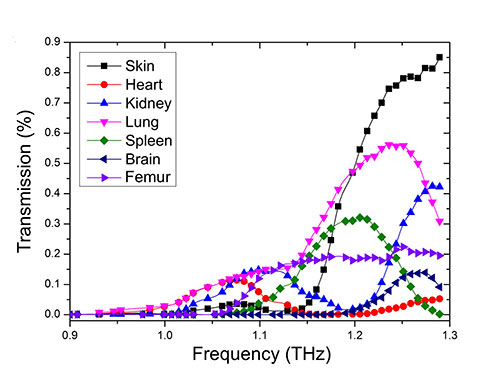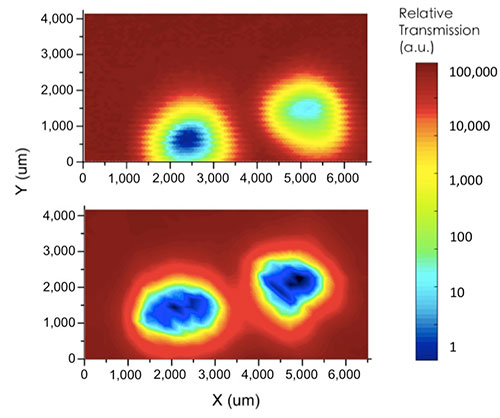Researchers at Tokyo Tech have developed an easy-to-use, tunable biosensor tailored for the terahertz (THz) range. Images of mouse organs obtained using their new device verify that the sensor is capable of distinguishing between different tissues. The achievement expands possibilities for terahertz applications in biological analysis and future diagnostics.

Figure 1. Images of the spiral plasmonic structure
(a) A photograph of the spiral bull's eye (SBE) structure, (b) a microscope image of the double-corrugated devices, and (c) a scanning electron microscope image of the eight-tip Siemens-star aperture at the center of the SBE structure.
Plasmonics is a term that describes both the study and applications of phenomena related to the interaction between light and metal surface electrons. Plasmonic-based materials are of interest in the development of technologies ranging from high-performance electronics to ultra-sensitive biosensors.
Scientists are exploring the possibilities of combining the advantages of plasmonics with emerging terahertz technologies as a way of developing new and enhanced methods for non-invasive detection and analysis. So far, however, the ability to detect tiny, biological samples has proven challenging, mainly because THz light waves have longer wavelengths than visible, infrared and ultraviolet light.
Now, Yukio Kawano and colleagues at Tokyo Tech's Laboratory for Future Interdisciplinary Research of Science and Technology working in collaboration with researchers at Tokyo Medical and Dental University have found a way to overcome this barrier by designing a frequency-tunable plasmonic-based THz device.
One of the key features of the new device is its spiral bull's eye (SBE) design (see Figure 1). Due to its smoothly varied grooves, "the groove period continuously changes with the diameter direction, resulting in continuously frequency-tunable characteristics," Kawano says in their study published in Scientific Reports.
Another advantage of the new design is that it incorporates a so-called Siemens-star aperture, which enables a user-friendly way of selecting the desired frequency by simply changing the rotation of the spiral plasmonic structure.
"The device also increases the electric field intensity at the subwavelength aperture, thus significantly amplifying the transmission," Kawano says.
In preliminary experiments to assess how well the new device could visualize biological tissues, the researchers obtained THz transmission spectra for various mouse organs, as shown in Figure 2.

Figure 2. Terahertz transmission spectra of bio-samples using the SBE
THz medical examination of sections of mice organ tissues for skin, heart, kidney, lung, spleen, brain, and femur. Transmission spectra were measured by rotating the SBE. The spectra revealed different transmission peaks characteristic of the organ tissues.
To probe further, they also conducted THz mapping of mouse tails. By comparing images obtained with and without the SBE design, the study showed that the former led to a markedly improved ability to distinguish between different tissues such as hair, skin and bone (see Figure 3). The findings suggest that the improved performance is due to the device’s tunability.

Figure 3. Visualization of the interior of mouse tails
Terahertz mapping of the mouse-tail samples using a conventional setup (upper image) and the SBE (lower image). The hair (yellow and red), skin (light blue), and bone (dark blue) were clearly distinguishable using the SBE.
The study acknowledges technical support from Tokyo Tech's Semiconductor and MEMS Processing Center.
Further investigations are planned to test the new device using various mouse organ tissues. The findings open up a new direction for plasmonic-based THz imaging of biological samples, which may eventually lead to the development of improved, non-invasive diagnostic imaging tools.
Reference
Authors : |
Xiangying Deng1, Leyang Li2, Mitsuhiro Enomoto2 and Yukio Kawano1 |
Title of original paper : |
Continuously Frequency-Tuneable Plasmonic Structures for Terahertz Bio-sensing and Spectroscopy |
Journal : |
Scientific Reports (2019) |
DOI : |
|
Affiliations : |
1 Laboratory for Future Interdisciplinary Research of Science and Technology, Department of Electrical and Electronic Engineering, Tokyo Institute of Technology
2 Department of Orthopaedic Surgery, Tokyo Medical and Dental University
|
. Any information published on this site will be valid in relation to Science Tokyo.





